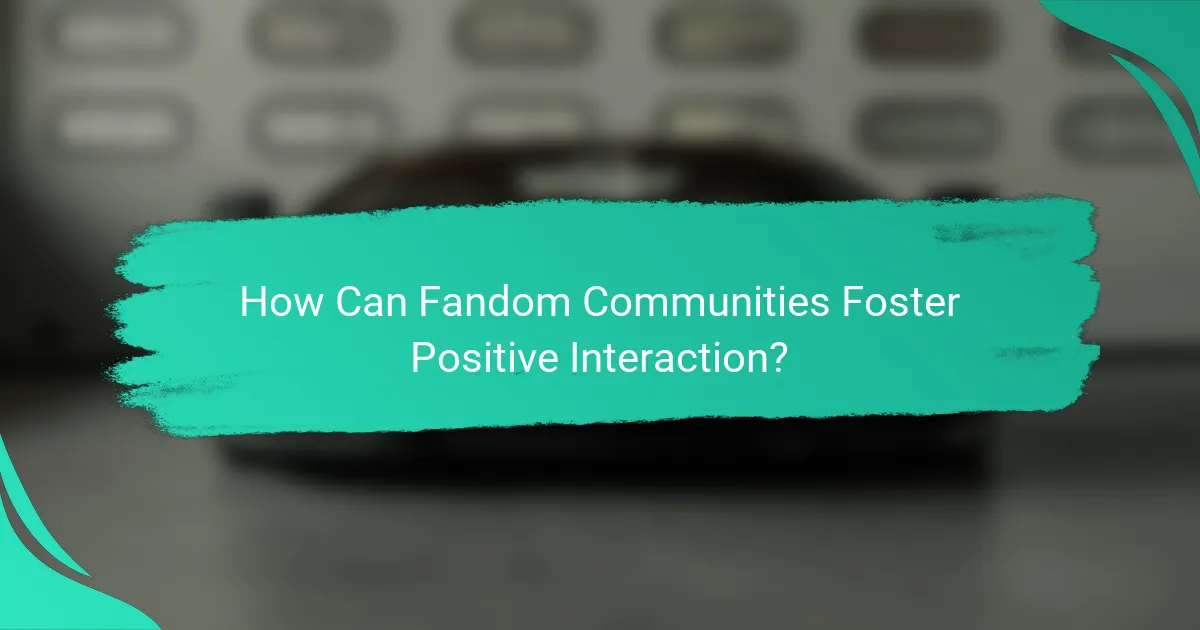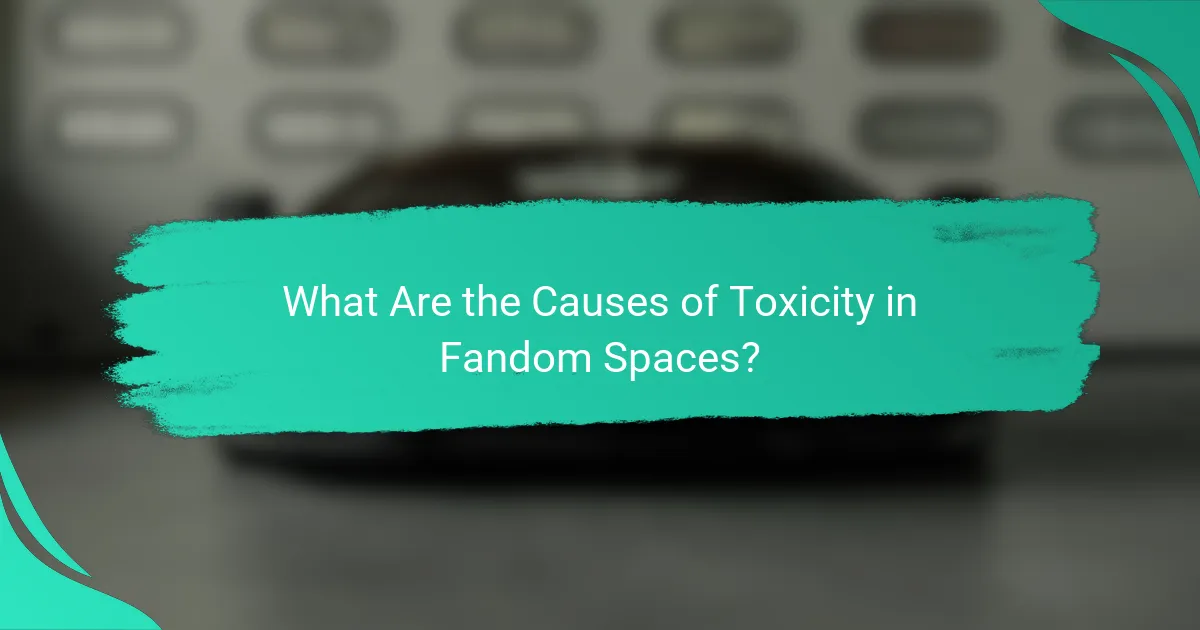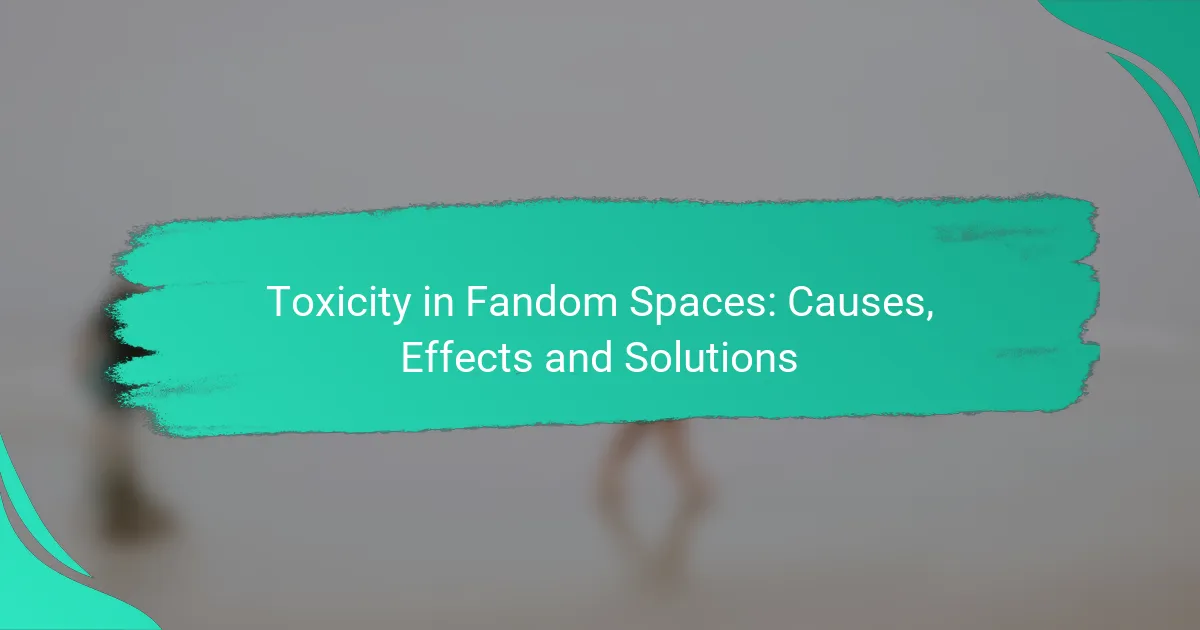Toxicity in fandom spaces poses significant challenges, often stemming from anonymous interactions, groupthink, and miscommunication. These negative dynamics can harm community engagement and alienate members, particularly those from marginalized backgrounds. Addressing this issue requires a comprehensive strategy that emphasizes inclusivity, safety, and support, fostering healthier environments for all fans.

What Are the Main Solutions to Toxicity in Fandom Spaces?
Addressing toxicity in fandom spaces requires a multifaceted approach that includes community moderation, conflict resolution, education, support for marginalized voices, and changes to platform policies. Implementing these solutions can create a healthier environment for all participants.
Community moderation tools
Community moderation tools empower users to manage interactions within fandom spaces effectively. Features such as reporting mechanisms, content filters, and user blocking can help mitigate harmful behavior. For example, platforms can enable users to flag inappropriate comments, which moderators can review and address promptly.
Additionally, implementing tiered moderation roles allows trusted community members to assist in maintaining a positive atmosphere. This approach fosters a sense of ownership and responsibility among users, encouraging them to contribute to a respectful environment.
Conflict resolution strategies
Effective conflict resolution strategies are essential for addressing disputes that arise within fandoms. Establishing clear guidelines for resolving conflicts can help prevent escalation and promote understanding. Techniques such as mediation and facilitated discussions can be beneficial in addressing grievances between users.
Encouraging open dialogue and active listening can lead to more constructive outcomes. Providing resources, such as conflict resolution workshops, can equip community members with the skills needed to navigate disagreements respectfully.
Education on respectful discourse
Education on respectful discourse is crucial for fostering a positive fandom culture. Initiatives that teach users about constructive communication, empathy, and the impact of their words can significantly reduce toxicity. Workshops, online courses, or informative articles can serve as valuable resources for community members.
Promoting awareness of diverse perspectives and experiences can enhance understanding and tolerance within fandoms. Encouraging users to think critically about their interactions can lead to more respectful and inclusive conversations.
Support for marginalized voices
Supporting marginalized voices is vital in combating toxicity and ensuring diverse representation within fandom spaces. Creating platforms for underrepresented groups to share their experiences and perspectives can enrich the community. This can include spotlighting creators from diverse backgrounds or hosting events that celebrate their contributions.
Additionally, fostering allyship among community members can amplify marginalized voices. Encouraging users to actively listen and advocate for those who may face discrimination can help create a more inclusive environment.
Platform policy changes
Implementing platform policy changes is essential for addressing systemic issues related to toxicity. Clear and enforceable community guidelines that outline acceptable behavior can deter harmful actions. Platforms should regularly review and update these policies to adapt to evolving community needs and challenges.
Moreover, establishing consequences for violations, such as temporary suspensions or permanent bans, can reinforce the seriousness of maintaining a respectful environment. Transparency in how policies are enforced can build trust within the community and encourage adherence to guidelines.

How Can Fandom Communities Foster Positive Interaction?
Fandom communities can foster positive interaction by prioritizing inclusivity, safety, and support among members. By creating environments where everyone feels welcome and valued, these communities can enhance engagement and reduce toxicity.
Encouraging inclusive events
Inclusive events are essential for fostering positive interaction in fandom communities. Organizing activities that cater to diverse interests and backgrounds helps ensure that all members feel represented. Consider hosting events that highlight various cultures, genres, or formats, such as panels, workshops, or themed gatherings.
When planning these events, seek input from community members to understand their preferences. This can include surveys or open forums where fans can share their ideas. Aim for a mix of activities that appeal to different demographics, ensuring that everyone has a chance to participate.
Creating safe spaces for discussion
Safe spaces for discussion are vital in promoting healthy dialogue within fandom communities. Establish clear guidelines for respectful communication and ensure that all members understand the expectations. This can help prevent misunderstandings and conflicts that may arise from differing opinions.
Utilize moderation tools and practices, such as appointing moderators for online forums or establishing rules for in-person discussions. Encourage members to report any harmful behavior and address issues promptly to maintain a supportive environment.
Implementing peer support systems
Peer support systems can significantly enhance the sense of community and belonging among fandom members. By creating mentorship programs or buddy systems, experienced fans can guide newcomers, helping them navigate the community and feel more comfortable.
Consider establishing regular check-ins or support groups where members can share their experiences and challenges. This fosters connection and reinforces the idea that everyone is valued and heard. Encourage open communication and provide resources for those who may need additional support, such as mental health resources or conflict resolution strategies.

What Are the Causes of Toxicity in Fandom Spaces?
Toxicity in fandom spaces often arises from a combination of anonymous online behavior, groupthink, and miscommunication. These factors can create an environment where negative interactions thrive, leading to harmful dynamics among fans.
Anonymous online behavior
The anonymity provided by online platforms can lead individuals to express themselves in ways they might not in face-to-face interactions. This can result in aggressive or derogatory comments, as the perceived lack of accountability encourages negative behavior.
For example, users may engage in harassment or bullying without fear of repercussions, which can escalate conflicts within fandoms. To mitigate this, platforms can implement stricter moderation policies and encourage users to adopt respectful communication practices.
Groupthink and echo chambers
Groupthink occurs when a homogenous group prioritizes consensus over critical thinking, often leading to toxic behavior. In fandoms, this can manifest as a refusal to accept differing opinions, creating echo chambers that reinforce negative attitudes.
When fans only interact with like-minded individuals, they may become more extreme in their views. Encouraging diverse discussions and exposing fans to a range of perspectives can help break down these echo chambers and reduce toxicity.
Miscommunication and misunderstandings
Miscommunication can easily occur in fandom spaces, often due to the rapid pace of online interactions and the use of slang or jargon. This can lead to misunderstandings that escalate into conflicts, as fans may misinterpret each other’s intentions or statements.
To reduce these issues, fans should strive for clarity in their communication and be open to asking for clarification when needed. Establishing guidelines for respectful dialogue can also help prevent misunderstandings from spiraling into toxicity.

What Are the Effects of Toxicity on Fandom Communities?
Toxicity in fandom communities can lead to significant negative consequences, impacting participation, inclusivity, and mental well-being. These effects can create an environment where individuals feel unwelcome or unsafe, ultimately diminishing the vibrancy of the community.
Decreased participation and engagement
Toxic behavior often drives away members who may feel uncomfortable or threatened, resulting in decreased participation in discussions and events. This disengagement can lead to a lack of fresh ideas and perspectives, stifling the community’s growth and creativity.
As fewer individuals contribute, the overall enthusiasm for the fandom may decline, leading to a cycle where toxicity breeds further disengagement. Communities may find themselves dominated by a small group of vocal members, which can create an echo chamber that discourages diverse viewpoints.
Exclusion of diverse voices
Toxicity can create an environment where only certain voices are heard, often marginalizing those from diverse backgrounds. This exclusion not only limits the richness of discussions but can also perpetuate harmful stereotypes and reinforce negative narratives within the fandom.
When diverse perspectives are silenced, the community risks becoming homogeneous, which can alienate potential new members who might feel that their experiences and opinions are unwelcome. Encouraging inclusivity is essential for fostering a healthy and vibrant fandom.
Negative mental health impacts
The effects of toxicity extend beyond the community, often impacting individuals’ mental health. Members may experience anxiety, depression, or feelings of isolation due to the hostile environment created by toxic interactions.
To mitigate these effects, communities should prioritize mental well-being by promoting respectful dialogue and establishing clear guidelines against harassment. Support systems, such as moderation teams and safe spaces, can help individuals feel more secure and valued within the fandom.

How Do Different Platforms Address Toxicity?
Different platforms tackle toxicity through a combination of content moderation policies and user reporting features. These measures aim to create safer environments for users while balancing freedom of expression.
Reddit’s content moderation policies
Reddit employs a system of community-driven moderation where individual subreddits establish their own rules. Moderators can remove posts, ban users, and enforce guidelines to curb toxic behavior. This decentralized approach allows for tailored moderation but can lead to inconsistencies across different communities.
Users can also report content that violates Reddit’s policies, which are reviewed by the platform’s administrators. However, the effectiveness of this system relies heavily on the vigilance of moderators and the community’s willingness to enforce standards.
Twitter’s reporting features
Twitter provides users with the ability to report tweets and accounts that engage in harassment or spread harmful content. The platform has specific categories for reporting, which helps streamline the review process. Users can expect a response from Twitter, but resolution times can vary significantly.
In addition to reporting, Twitter has implemented features like muting and blocking to empower users to manage their interactions. While these tools can help reduce exposure to toxicity, they do not eliminate the problem entirely, as harmful content can still proliferate before being addressed.
